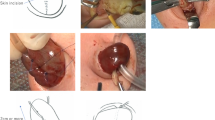Abstract
Purpose
To assess the long-term cosmetic outcomes of the “slit-slide procedure”, designed to provide a more natural appearance for umbilical hernia repair, as perceived by the patients and their parents.
Methods
A total of 149 patients with umbilical hernia underwent the slit-slide procedure at our hospital. The slit-slide procedure allows for the creation of an umbilicus with a more natural and integrated appearance. The patient satisfaction survey questionnaire was mailed to the families (n = 139), and there were 74 (53.2%) respondents. A questionnaire survey on postoperative appearance was also distributed to pediatric surgeons.
Results
The median age at the time of operation was 2.5 years (range, 2 months to 14 years) and the average median age at the time of answering the questionnaire was 6.25 years old (range, 2.5–14.8 years). The average median period of observation was 3.2 years (range, 4 months to 8.97 years). Most patients (89.2%) and parents (93.2%) were satisfied with the appearance of the umbilicus. Twenty-seven patients reported improved satisfaction after surgery (36.2%). Surgeons tended to score the elongated-oval shape highly; however, there was no difference in satisfaction among the shapes.
Conclusion
The slit-slide procedure is not only effective and safe, but it achieves a satisfactory aesthetic outcome.



Similar content being viewed by others
References
Yanagisawa S, Kato M, Oshio T, Morikawa Y. Reappraisal of adhesive strapping as treatment for infantile umbilical hernia. Pediatr Int. 2016;58(5):363–8.
Kajikawa A, Ueda K, Suzuki Y, Ohkouchi M. A new umbilicoplasty for children: creating a longitudinal deep umbilical depression. Br J Plast Surg. 2004;57(8):741–8.
Zenitani M, Sasaki T, Tanaka N, Oue T. Umbilical appearance and patient/parent satisfaction over 5 years of follow-up after umbilical hernia repair in children. J Pediatr Surg. 2018;53(7):1288–94.
Sugita K, Noguchi H, Matsukubo M, Murakami M, Machigashira S, Ieiri S. Treatment results of the VY flap method of lnverse Y-shaped lncision: a questionnaire survey on patient satisfaction. Jpn J Pediatric Surg. 2021;57:938–45.
Sakamoto Y, Kamagata S, Hirobe S, Hayashi A. Umbilical shape by age and growth: a Japanese study. Plast Reconstr Surg. 2010;126(2):97e-e98.
Horisawa M, Ogura Y, Matsunaga K. New technique for umbilical hernia operation: slit-slide procedure. Jpn J Pediatric Surg. 1999;31(8):739–975.
van Veldhuisen CL, Kamali P, Wu W, Becherer BE, Sinno HH, Ashraf AA. Prospective, double-blind evaluation of umbilicoplasty techniques using conventional and crowdsourcing methods. Plast Reconstr Surg. 2017;140(6):1151–62.
Correia N, Jayyosi L, Chiriac S, Renard Y, Raimond E, Poli-Merol ML, Chaput B, François C. Morphometric analysis of the umbilicus according to age. Aesthetic Surg J. 2018;38(6):627–34.
Craig SB, Faller MS, Puckett CL. In search of the ideal female umbilicus. Plast Reconstr Surg. 2000;105(1):389–92.
Graham KA, Livingston RJ. Ideal male umbilicus: an observational study of surface anatomy and introduction to the SHAPE classification. Aesthetic Plast Surg. 2022. https://doi.org/10.1007/s00266-022-02798-7.
Hayashida M, Shimozono T, Meiri S, Kurogi J, Yamashita N, Ifuku T. Umbilical hernia: influence of adhesive strapping on outcome. Pediatr Int. 2017;59(12):1266–9.
Zendejas B, Kuchena A, Onkendi EO, Lohse CM, Moir CR, Ishitani MB. Fifty-three–year experience with pediatric umbilical hernia repairs. J Pediatr Surg. 2011;46(11):2151–6.
Zens T, Nichol PF, Cartmill R, Kohler JE. Management of asymptomatic pediatric umbilical hernias: a systematic review. J Pediatr Surg. 2017;52(11):1723–31.
Chemaly M, El-Rajab MA, Ziade FM, Naja ZM. Effect of one anesthetic exposure on long-term behavioral changes in children. J Clin Anesth. 2014;26(7):551–6.
Acknowledgements
The authors appreciate Dr. Masahiro Zenitani (Department of Pediatric Surgery, Osaka Women’s and Children’s Hospital) who gave us information about the questionnaire and suggestions. The authors appreciate the pediatric surgeons who rated the appearance scores (Dr. K.N and R.M from Miyazaki University, Dr. M.K and Dr. T.B from Ryukyu University, and Dr. M.M and Dr. M.T from Kagoshima City Hospital and Dr. M.M and Dr. S.I from Kagoshima University). The authors appreciate Mr. Brian Quinn for his comments and help with the manuscript. This work was supported by JSPS KAKENHI under Grant Nos. 18K16262 and 22K15925.
Author information
Authors and Affiliations
Corresponding author
Ethics declarations
Conflict of interest
We have no conflicts of interest in association with the present study.
Additional information
Publisher's Note
Springer Nature remains neutral with regard to jurisdictional claims in published maps and institutional affiliations.
Electronic supplementary material
Below is the link to the electronic supplementary material.
Supplementary file1 (MP4 10831 KB)
Supplementary file2 (MP4 46331 KB)
Appendix
Rights and permissions
Springer Nature or its licensor (e.g. a society or other partner) holds exclusive rights to this article under a publishing agreement with the author(s) or other rightsholder(s); author self-archiving of the accepted manuscript version of this article is solely governed by the terms of such publishing agreement and applicable law.
About this article
Cite this article
Onishi, S., Esumi, G., Fukuhara, M. et al. Long-term cosmetic outcomes of the slit-slide procedure for umbilical hernia repair in children. Surg Today 54, 565–573 (2024). https://doi.org/10.1007/s00595-023-02760-3
Received:
Accepted:
Published:
Issue Date:
DOI: https://doi.org/10.1007/s00595-023-02760-3





